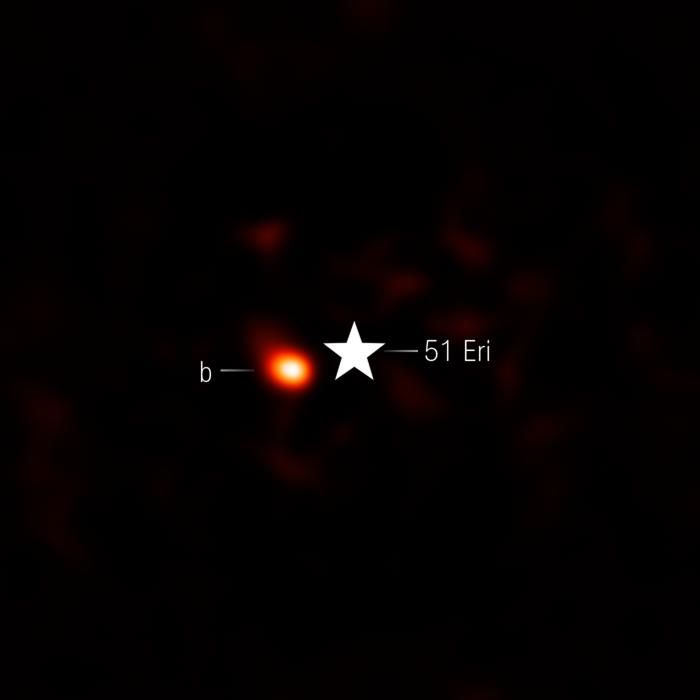The JWST has spotted the presence of carbon dioxide on HR 8799’s four known planets, part of a system astronomers use to explore the formation of our own system. The results are consistent with models of how the Solar System’s giant planets formed.
ADVERTISEMENT
There are two models for planet formation, known as top-down and bottom-up. It’s thought those in the Solar System, including Jupiter and Saturn, took the bottom-up path, starting by building solid cores. In the case of the gas giants, these then became surrounded by hydrogen and helium to reach their immense sizes.
What astronomers are less confident about is how universal this is, so observing the process in other systems is important. The HR 8799 system is about 30 million years old. It’s also 130 light years away, which is close by the standards of star systems at such an interesting stage of development.
Normally we could not see planets directly at this distance, even with the JWST, but the planets in the HR 8799 system are so young that they are still intensely hot from the formation process. Consequently, they produce enough infrared radiation to be seen directly. There’s even a video of their movements over 12 years.
Seeing the planets is one thing, but the JWST can go further. It detects the distinctive color of each planet, revealing the composition of its upper layers by telling us which wavelengths are absorbed.
Johns Hopkins PhD student William Balmer is the first author of a study that compared the JWST’s observations of the system with those of a somewhat closer and younger system, 51 Eridani.
“By spotting these strong carbon dioxide features, we have shown there is a sizable fraction of heavier elements, such as carbon, oxygen, and iron, in these planets’ atmospheres,” Balmer said in a statement. “Given what we know about the star they orbit, that likely indicates they formed via core accretion, which for planets that we can directly see is an exciting conclusion.”
ADVERTISEMENT
If formed top-down, planets would be expected to have a similar composition to their star. Measuring the proportion of elements heavier than helium in HR 8799 has proven unusually difficult, but we don’t think it’s this high.
The observations revealed much less about 51 Eridani b, the system’s only known planet, but do back up the previous suspicion that it has a very eccentric (elongated) orbit.

51 Eridani b is less revealing of its composition, but at least we’re learning about the orbit of such a young planet.
Image credit: NASA, ESA, CSA, STScI, W. Balmer (JHU), L. Pueyo (STScI), M. Perrin (STScI)
In addition to carbon dioxide, the JWST found carbon monoxide and methane in differing quantities between the planets, hinting at differences in their formation.
“We have other lines of evidence that hint at these four HR 8799 planets forming using this bottom-up approach,” said study co-lead Dr Laurent Pueyo of the Space Telescope Science Institute. “How common is this for long period planets we can directly image? We don’t know yet, but we’re proposing more Webb observations, inspired by our carbon dioxide diagnostics, to answer that question.”
ADVERTISEMENT
Hot as they are, the planets in these systems are overshadowed by their stars in images taken from Earth. However, without an atmosphere to smear that light around, the JWST’s coronagraph can more effectively block the star’s light so that the planets are clear enough that we can even see specific gases.
The JWST identified the presence of carbon dioxide in WASP-39 b when it passed between us and its star, but that was considered an indirect detection, noting absorption lines in the star’s spectrum. In contrast, the latest discovery was direct, observing a specific color associated with carbon dioxide.
That said, when it comes to finding carbon dioxide, and gases more strongly indicative of life, in the atmosphere of rocky planets, it’s the indirect method we’re likely to rely on.
Even in billions of years’ time, none of these planets will be suitable for life, but that doesn’t mean they don’t affect the habitability of their system. Besides the possibility of life on future moons, Balmer noted, “If you have these huge planets acting like bowling balls running through your solar system, they can either really disrupt, protect, or do a little bit of both to planets like ours, so understanding more about their formation is a crucial step to understanding the formation, survival, and habitability of Earth-like planets in the future.”
ADVERTISEMENT
The authors also celebrate the fact the JWST could identify the color given by carbon dioxide to HR 8799e, the innermost of the system’s four known planets, and therefore the one hardest to distinguish from the star’s glare.
The study is published in The Astronomical Journal.
Source Link: JWST Finds Its First Carbon Dioxide In Planets Outside The Solar System